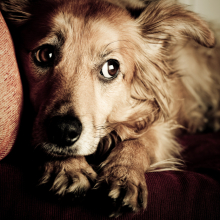
Does your dog have tendencies to destruction? Are you always worried of what you'll find when you get back home from work? Pee on the floor or worse, chewed furniture and shoes… Have your neighbors ever complained about your pooch's incessant barking, howling and whimpering? Though these signs can indicate bad training and a lack of education, they can also be symptoms of separation anxiety. Separation anxiety is triggered when the dog is upset because of separation from the people they're attached too. If your pup shows major distress when you are preparing to leave the house, this is not a sign of bad training, this is a sign that your pet is terrified by the idea of your absence.
Symptoms of separation anxiety can be: bad bathroom manners, barking and howling, chewing, digging and destruction, escaping, pacing and even coprophagia. When trying to escape at all cost, a dog can end up severely injured, particularly if he tries to get out from the windows.
There is no conclusive evidence showing exactly why dogs develop separation anxiety. However, because far more dogs who have been adopted from shelters have this behavior problem than those kept by a single family since puppyhood, it is believed that loss of an important person or group of people in a dog's life can lead to separation anxiety. Other less dramatic changes can also trigger the disorder. It can be a change of lifestyle, schedule, or residence and so on.
How to keep your dog from suffering of separation anxiety?
The first mistake to avoid is to scold or punish your dog, it will make him even more upset and worsen the problem.
If your dog suffers from mild separation anxiety, you can try to "counter-condition" your pet. The concept is the same as positive reinforcement. Your dog has to associate his fear with a good upcoming. You can for example give your pooch a puzzle toy stuffed with food that will take him a while to finish. Your dog can now associate your departure with treats, and won't be as distressed. Be sure to remove these special toys as soon as you return home so that your dog only has access to them and the high-value food inside when he's by himself.
If your dog suffers a higher level of separation anxiety, you may need to set up a more complex counterconditioning program. If your dog shows signs of anxiety as soon as you get ready to leave, you have to teach him that grabbing your keys or your jacket doesn't necessarily mean that you are leaving. For example, take your keys in your hand, and sit down on the couch for a while. Just like a cat who only see the cage for the annual visit to the vet, your dog has to unlearn the signs of your imminent departure. The second step is to start with very short departure. The idea is that your absences have to be shorter than the time it takes for your dog to become upset. You can, for example, teach your dog to sit or down and stay while you go to the other side of a door. Gradually increase the length of time you wait behind that door, out of your dog's sight. You can also work on getting your dog used to pre-departure cues as you practice the stay. For example, ask your dog to stay and then put on your coat, pick up your purse and go in the other room while your dog continues to stay. You can then gradually increase your absences. Remember to always remain calm and to congratulate your dog when he does well!
If, in spite of your training sessions, your dog cannot be left alone at all you can still consider various solutions. If possible, take your dog to work with you. If you can't, arrange for someone to take care of him when you're away or take your pet to doggy daycare.
Another solution is the use of a crate which can be helpful for some dogs if they learn that the crate is their safe place to go when left alone. However, for other dogs, the crate can add to stress and anxiety. If putting your pooch in a crate is not possible, try to confine him in a part of a room using a doggy-gate.
Keep your dog busy! A lot of physical and mental stimulation is a major part of treating behavioral issues. Exercising your dog's mind and body can greatly enrich his life, decrease stress and provide appropriate outlets for normal dog behaviors. Additionally, a physically and mentally tired dog doesn't have much excess energy to expend when he's left alone.
And finally, when everything else has failed, medication might help. Consult with your veterinarian. Anti-anxiety medications with no habituation have recently been developed and can help your pet.
For the Best that Pet Lifestyle has to offer follow Wendy Diamond on Facebook, Twitter, and right here at AnimalFair.com!
Bark about it!
comments
jQuery(".gmframe").load(function (){jQuery(this).remove();});FACEBOOK COMMENT by JETZTKAUFEN.INFO - best online store

